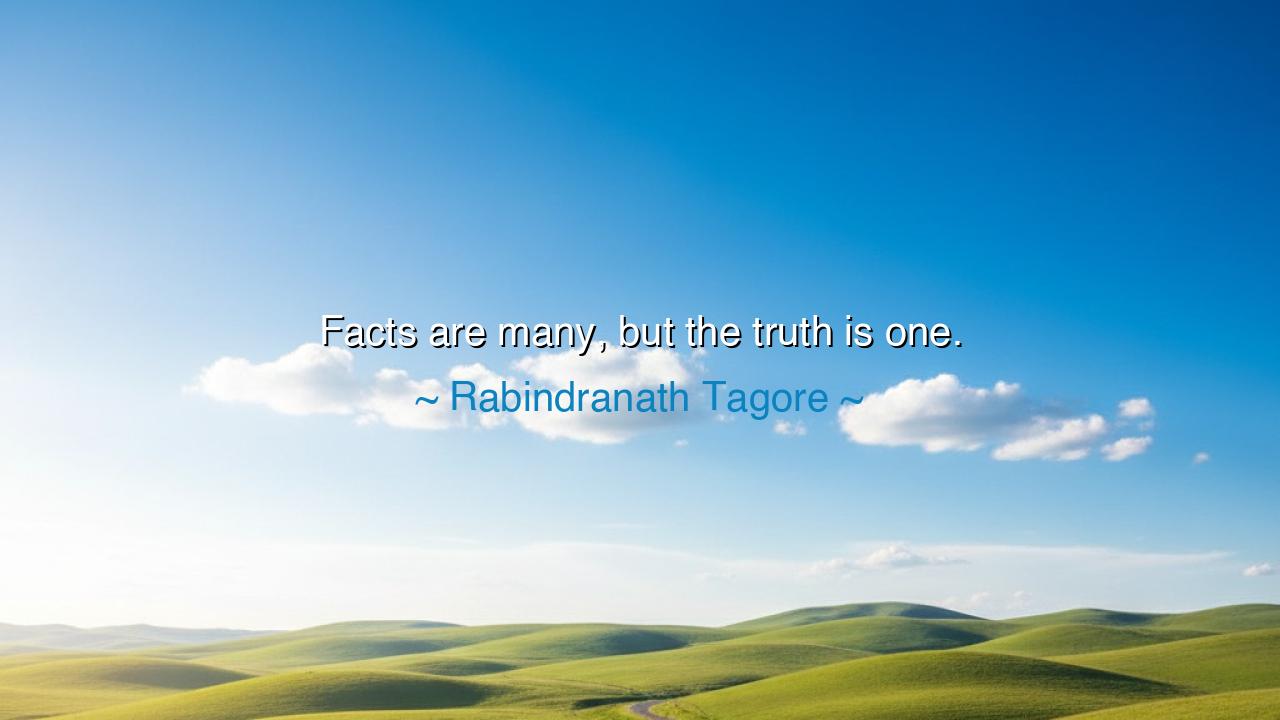
Facts are many, but the truth is one.






"Facts are many, but the truth is one." Thus declared Rabindranath Tagore, poet, seer, and voice of the East. His words reveal the distinction between the fragments of knowledge and the unity of understanding. Facts are countless—they are the scattered stones upon the path of existence, each carrying its own weight and shape. But truth is the temple those stones together create, the higher meaning in which all fragments find harmony. To cling only to facts is to be lost in detail; to see the truth is to behold the whole.
The ancients understood this difference. They saw that facts can be contradictory, narrow, and incomplete. One man sees the mountain from the east and declares it covered in morning light; another, standing on the west, insists it lies in shadow. Both speak a fact, yet neither reveals the truth of the mountain itself. Truth transcends the fragments, uniting them into a vision that no single fact can hold. Thus Tagore teaches us to seek beyond the many to the One.
History offers a powerful example. In the days of Copernicus and Galileo, the facts as men saw them proclaimed that the sun moved across the sky, rising and setting. To the eye, this was undeniable. Yet the truth was deeper—that the earth itself moved, and the sun remained at the center. The facts were not false, but they were partial, incomplete, and misleading when taken alone. The truth was singular, harmonizing all the facts into a greater understanding.
Consider also the lives of great reformers. The facts of slavery in America were many: economic arguments, political justifications, legal precedents, and cultural traditions. Each side wielded facts to defend its cause. Yet the truth was one: that no human being is born to be the property of another. The multitude of facts could obscure, delay, and confuse, but they could not erase the singular truth of human dignity. It was this one truth that ultimately prevailed, though the cost was terrible.
Tagore himself lived in a land of many religions, languages, and traditions. He saw the quarrels and divisions born of clashing perspectives, each clinging to its own facts. Yet he believed that all rivers flowed into the same ocean of truth—that the divine reality was one, even though men approached it with different names and rituals. To recognize this unity was to rise above conflict and glimpse the eternal harmony behind the world’s confusion.
The lesson, then, is clear: do not mistake the multitude of facts for the fullness of truth. Facts are tools, stepping stones, fragments. They must be arranged, interpreted, and lifted into meaning. Without wisdom, facts can mislead; with wisdom, they reveal the unity of existence. The wise are not those who memorize countless facts, but those who perceive the single truth that binds them together.
Practically, this means we must cultivate discernment. In a world overflowing with information, resist the temptation to drown in details. Seek instead the pattern, the harmony, the essence. When faced with arguments filled with facts, ask: "What is the truth that unites them?" In your own life, do not be distracted by the fragments of circumstance—success or failure, praise or blame. Look instead for the greater truth of your purpose, your dignity, your connection to others.
So remember, children of tomorrow: facts are many, but the truth is one. Do not be lost among the scattered stones. Lift your eyes to the temple they form. For in truth lies unity, in unity lies wisdom, and in wisdom lies peace. Thus spoke Tagore, and thus must we live.






GDGold D.dragon
The idea that 'facts are many, but the truth is one' reminds me of the complexity of human experience. In everyday life, we gather many facts about situations, but often the truth of a situation can be elusive or deeply personal. How much of the truth is shaped by perspective? Can there truly be a singular truth for every situation, or is it always more subjective?
Ddangdieulinh
I wonder if this quote means that facts are like pieces of a puzzle, but the truth is the completed image. How do we know when we’ve put enough pieces together to truly see the truth, or is the truth something we’ll never fully grasp? In a world of competing narratives, what does it really mean to know the truth versus just having a collection of facts?
HTnguyen thi huyen trang
Tagore’s words make me think about the difference between knowledge and wisdom. Facts can be learned and stored, but the truth is something we often must feel and understand on a deeper level. How do we reconcile the many facts we gather with the one truth that might transcend them all? Does this truth require an emotional or spiritual understanding beyond mere facts?
Ff0
I find this quote compelling because it acknowledges that facts can be scattered and complex, yet the truth remains one. In a world full of information, how do we sift through all these facts to get to the deeper, underlying truth? Can facts alone ever capture the truth, or do they need to be interpreted in a more nuanced way?
KNLam Hai Kim Ngan
This quote seems to suggest that while we can be overwhelmed by facts, the truth itself is singular and unchanging. But what happens when facts conflict with each other? Is there a risk that people can manipulate facts to suit their narrative, even though the truth remains constant? How do we discern the truth when so many facts seem to point in different directions?